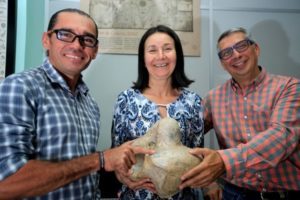
With 51,100km2, Costa Rica’ accounts for only 0.03 percent of the earth’s surface. In spite of its size, its biodiversity is truly amazing. It has been estimated that the country possesses the highest density of biodiversity in the world. This fact has made Costa Rica a hotspot for nature lovers.
High in the Costa Rican trees lives one of the slowest animals on Earth. Its appearance has gained it the affection of people worldwide and has turned it into a magnet for tourists. It is the tree sloth or perezoso, of which two species inhabit the forests: the “bayo” sloth (Bradypus variegatus), with three claws, and the two-fingered Hoffmann’s sloth (Choloepus hoffmanni).
Eleven Sloth Facts
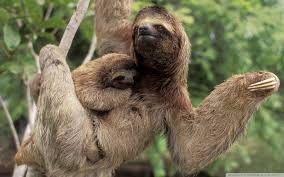
– These mammals were named after the sin of sloth, as they are slow-moving and seemingly lazy.
– Costa Rica holds one of the most numerous tree sloth populations in the world. They can be found at Limon on the Caribbean side and in Manuel Antonio National Park on the Central and South Pacific side.
– Since 2010 there is an International Sloth Day. It was created by AIUNAU Foundation, a Colombia-based non-profit conservation, and wildlife group.
– Female sloths emit loud screams to indicate males that they are ready to mate. They have a single pup a year.
– Sloths are related to the giant ground sloth, that belonged to a group of elephant-sized mammals that inhabited the Américas in prehistoric times. The group became extinct about 11,000 years ago.
– Sloth’s fur provides shelter for swarms of insects such as moths and flies.
– There are also algae and fungi in the fur. A recent study revealed that some of these fungi may have medical uses against diseases like malaria and Chagas.
– Sloths use their algae as camouflage. During the rainy season the “algae gardens” they carry in their fur turn as green as the forest and the sloths become very hard to spot in the jungle’s canopy.
– Although sloths are slow on land (they have been clocked at a maximum climbing speed of about eight feet per minute) they are very good swimmers.
– Along with anteaters, and armadillos, sloths belong to a group of placental mammals called Xenarthra. Today, they only exist in the Americas. Xenarthra means “strange joints”.
– Sloths are herbivorous. As a result, they have very slow metabolisms. They spend most of their life on the treetops to avoid their predators and to get food and water. They go down from the safety of their trees once a week to poo.
The Curse of Cuteness
There are some wild animals that we find particularly attractive. We give them human traits like an easy going nature, an apparent fondness for hugs or human interaction and a perpetual smile. Unfortunately for them, they have been cursed with cuteness. They make most of us go ‘aww’ and say: I want one! And most of us do not care or do not pay attention to the consequences. We tend to believe they would make good pets. Toucans, dolphins, parrots, panda bears, koalas, hedgehogs and of course tree sloths are often part of the cute list. A case in point is the sloth movie star Flash Slothmore. He is a male three-toed sloth character in the 2016 animated film Zootopia.
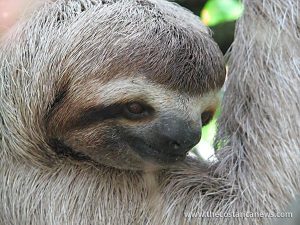
– Sloths are not good pets. They have a lot of special requirements, like special diets and the same kind of humidity and temperature -about 90 to 100 degrees with 80 to 90% humidity- they enjoy in the forest to survive in an alien environment (namely: outside their native jungles).
– Some microbes and allergens we carry can compromise their immune system.
– They do not like (or need) to be petted, groomed or bathed. That destroys the ecosystem they carry in their fur and endangers their lives.
– Improper handling can give sloths tachycardia and weaken their heart muscles, shortening their lifespan.
– Varieties like the three-toed sloth can be dangerous. They can use their big claws to inflict serious wounds when scared or bothered. This variety usually does very poorly in captivity.
Love Can Kill
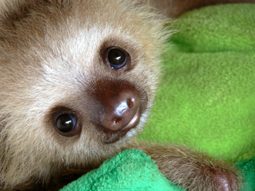
Most of the sloths (and many other exotic pets) we see in the markets were forcibly removed from nature, with very destructive consequences, both for the species and for the environment. According to Smithsonian.com “…animal trafficking now ranks just after gun and drug sales as the most profitable illegal industry.” So when you buy or even get a picture with a cute baby sloth, it is very likely you are becoming part of the illegal trade of exotic pets and helping destroy the same nature you have come to visit and enjoy.
Sloths have natural enemies like jaguars, eagles, and anacondas. They have adapted to each other and both predator and prey have survived for millions of years. Sadly, by destroying their environment and helping the pet trade we humans are becoming their worst enemy.
So please, leave sloths (and all wildlife) alone!
Sloth Care
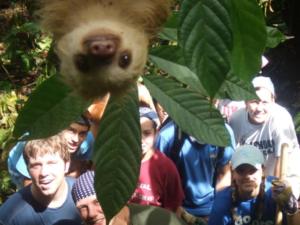
There are many sloths care and wildlife rescue centers in Costa Rica. They work to rehabilitate and liberate sloths and other animals that, in most cases, have been victims of human activity. Some of them are:
– Centro de Rescate-Reserva Ecológica Paraíso Carlisa.
– Centro de Rescate Santuario del Perezoso en Costa Rica. Located in Cahuita. They offer “An interactive tour with Nature”. It is about 11 km (7 miles) before arriving at Cahuita.
– The Buttercup Sloth Centre offers tours. They were the very first center that takes care of sloths exclusively. You can even “adopt” a sloth.


